 USD – US Dollar
USD – US Dollar
In the short run, the dollar should be supported by the US economy’s relative outperformance, which will allow the Fed to normalize policies more swiftly. During periodic periods of risk aversion, the USD should profit even more from its function as a liquid safe-haven currency. We expect the US economic outperformance to fade in the medium run, and the Fed to begin gradual policy normalization, keeping US real rates and yields negative. This, combined with central bank tightening outside of the US, could stimulate diversification movements away from the dollar, particularly given concerns about the US twin deficits and the USD’s overvaluation.
CAD – Canadian Dollar
The boost to Canada’s terms of trade has more than offset the market jitters stemming from the Ukraine-Russia war. The energy markets risk being durably impacted and higher prices could subsequently linger for longer. Besides, the BoC is off to an earlier and faster tightening start than the Fed in H122. Some gradual CAD outperformance could tentatively resume over the USD, while a significant cooling on the geopolitical front may be needed for CAD gains to become more entrenched.
EUR – Euro
The war in Ukraine has fanned stagflation headwinds in the Eurozone and should continue to complicate the ECB’s plans for policy normalization and weigh on the EUR across the board. It will further have lasting consequences for the Eurozone’s international competitiveness, external position, relative real yields and commodity terms of trade. Many negatives seem to be in the price of EUR/USD and its outlook in the coming months could stabilize in part thanks to the repatriation of funds held abroad into the Eurozone to fund the growing domestic outlays.
GBP – British Pound
Soaring energy costs, labor market shortages, global supply chain disruptions and persistent Brexit-related headwinds continue to plague the UK economic recovery and thus complicate the BoE’s ability to normalize in the face of uncomfortably high inflation. This could keep UK real rates and yields very negative and weigh on the GBP in the near term. In the longer term, the undervalued GBP may recover as UK growth hurdles ease and this allows the BoE to hike rates more aggressively.





 Forex Currency Stock API is able to provide real-time exchange rate data for global currencies. This API comes with multiple endpoints, each serving a different usage state. Endpoint functionality includes getting the latest exchange rate data for all currencies or a specific set of currencies, converting currency from one currency to another, restoring time series data for a currency or multiple currencies, and querying the daily volatility data API.
Forex Currency Stock API is able to provide real-time exchange rate data for global currencies. This API comes with multiple endpoints, each serving a different usage state. Endpoint functionality includes getting the latest exchange rate data for all currencies or a specific set of currencies, converting currency from one currency to another, restoring time series data for a currency or multiple currencies, and querying the daily volatility data API.